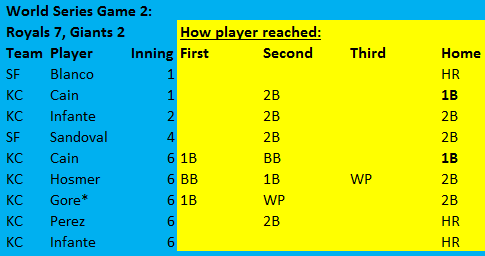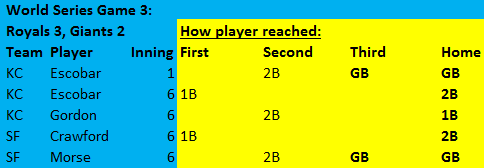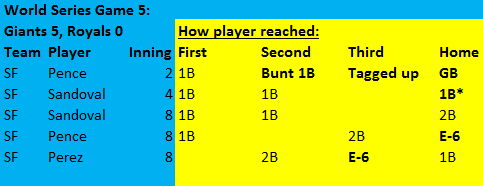By Jon Weisman
I’m going to discuss the Dodger offense from a different direction than I typically do.
The 2015 Dodgers lead the National League in walks, home runs, on-base percentage, slugging percentage, OPS, adjusted OPS and weighted runs created.
Despite this — and understandably, I’ll concede, given how inconsistent it has been for the past month — many have criticized the Dodger offense as incapable of generating runs in the pressure cooker of October.
Among other things, Los Angeles is the worst basestealing team around, and it gets less value from its baserunning than any NL team, according to Fangraphs. A hit-and-run dynamo, the Dodgers are not.
In contrast, you don’t get very far chatting about the World Champion San Francisco Giants without hearing praise for how their ability to manufacture runs carried them to the top.
So what I wanted to look at was how the rival Giants won the 2014 World Series, against a Kansas City Royals team that was also lauded for making things happen through smart, aggressive play on its way to the American League pennant. I’ve broken down every single run of last year’s Fall Classic — seven games, 57 runs — to see how important manufacturing runs was.
The Giants won’t get extra credit for drawing a walk or bashing extra-base hits. Rather, my question today is this: Where did bunting, stolen bases, productive outs and taking the extra base on a hit play a role? (The Royals’ performance in these areas will also be noted — after all, they were within 90 feet of sending Game 7 into extra innings.)
What I found was rather diverse — games where manufacturing runs was key, games where it was irrelevant and games in between. And then there was the small matter of Madison Bumgarner having the postseason of the century.
Note: The charts below delineate how every player who scored in the World Series got from the batter’s box around the bases. A play in bold indicates a moment where you could say a base was manufactured.
 Game 1 synopsis: Gregor Blanco set a tone by tagging up from first to second on a first-inning fly ball, but that tone played little role in the Giants’ victory. Complimenting Bumgarner’s seven innings of one-run ball, San Francisco slugged its way to its Game 1 win. Four of the Giants’ runs were driven home by extra-base hits, two others by singles that followed extra-base hits.
Game 1 synopsis: Gregor Blanco set a tone by tagging up from first to second on a first-inning fly ball, but that tone played little role in the Giants’ victory. Complimenting Bumgarner’s seven innings of one-run ball, San Francisco slugged its way to its Game 1 win. Four of the Giants’ runs were driven home by extra-base hits, two others by singles that followed extra-base hits.
* * *
 Game 2 synopsis: We’ll give Kansas City a smidge of credit for driving home two runners from second on singles, but the Royals’ win was basically a triumph of getting on base 12 times — including five extra-base hits. Worth noting: Kansas City would have had a bigger first inning if leadoff hitter Alcides Escobar hadn’t been caught stealing.
Game 2 synopsis: We’ll give Kansas City a smidge of credit for driving home two runners from second on singles, but the Royals’ win was basically a triumph of getting on base 12 times — including five extra-base hits. Worth noting: Kansas City would have had a bigger first inning if leadoff hitter Alcides Escobar hadn’t been caught stealing.
* * *
 Game 3 synopsis: In the first close game of the Series, each team scored a runner from second base on two grounders, and each team scored a runner from first on a double. The difference-maker for Kansas City came when Eric Hosmer singled home Alex Gordon from second base in the sixth inning, without a throw.
Game 3 synopsis: In the first close game of the Series, each team scored a runner from second base on two grounders, and each team scored a runner from first on a double. The difference-maker for Kansas City came when Eric Hosmer singled home Alex Gordon from second base in the sixth inning, without a throw.
Productive outs made some impact on this game, but neither team had a sacrifice, the only stolen-base attempt ended in an out, and Hosmer’s single was the only hit by either team with a runner in scoring position. The teams combined to go 1 for 9 with RISP.
* * *
 Game 4 synopsis: This was a close game disguised as a rout, with the Giants trailing, 4-2, at the halfway point and tied going into the bottom of the sixth.
Game 4 synopsis: This was a close game disguised as a rout, with the Giants trailing, 4-2, at the halfway point and tied going into the bottom of the sixth.
San Francisco got a little-ball run in the first inning and — after the Royals strung together several baserunners in a four-run third — the Giants had a productive out lead to a run in the fourth.
Two more productive outs helped San Francisco tie the game in the bottom of the fifth, and bunts played a key role as the Giants poured it on in the sixth and seventh. (Even Buster Posey being intentionally walked was set up by a sacrifice.)
With the Giants amassing 16 hits and six walks, this probably was a triumph of OBP more than anything, but I’m fine with putting this victory in the manufactured column.
* * *
 Game 5 synopsis: This was a Bumgarner shutout special, so not really a story about the offense, but the Giants did win with only one extra-base hit, which they redeemed in the eighth inning, by the time the game was all but decided. The first inning offered textbook manufacturing of a run.
Game 5 synopsis: This was a Bumgarner shutout special, so not really a story about the offense, but the Giants did win with only one extra-base hit, which they redeemed in the eighth inning, by the time the game was all but decided. The first inning offered textbook manufacturing of a run.
* * *
 Game 6 synopsis: Kansas City simply pounded the Giants with four walks and 15 hits – including six doubles and a homer. A few runners took an extra base on a hit, but this was an OBP win against an overmatched Jake Peavy.
Game 6 synopsis: Kansas City simply pounded the Giants with four walks and 15 hits – including six doubles and a homer. A few runners took an extra base on a hit, but this was an OBP win against an overmatched Jake Peavy.
* * *
 Game 7 synopsis: By the time Bumgarner entered in the bottom of the fifth inning, the Giants had the three runs that he would need to close out the team’s third World Series title in five years. All three San Francisco runs involved a runner tagging up on a fly ball and taking an extra base. I’ve bolded those moments above, though they don’t really strike me as manufacturing runs in a way that the 2015 Dodgers couldn’t do.
Game 7 synopsis: By the time Bumgarner entered in the bottom of the fifth inning, the Giants had the three runs that he would need to close out the team’s third World Series title in five years. All three San Francisco runs involved a runner tagging up on a fly ball and taking an extra base. I’ve bolded those moments above, though they don’t really strike me as manufacturing runs in a way that the 2015 Dodgers couldn’t do.
The Dodgers are currently tied (with the Giants) for last in the NL in sacrifice flies, but put 11 of their home runs into outfielder gloves, and the Dodgers would be leading the league in sacrifice flies and home runs alike.
* * *
At the end of it all, San Francisco won the 2014 World Series in the final game by one run, using a pitcher who had a 2.98 ERA in the regular season but, in one of the greatest championship performances this sport has ever seen, pitched 21 World Series innings and shut out his opponent in 20 of them.
Much of the 2015 Dodgers’ fate will depend on whether their pitching can step up in the 2015 playoffs in a way that it didn’t in 2014, outside of Zack Greinke for seven innings in Game 2 or Clayton Kershaw and Hyun-Jin Ryu for the first six innings of Games 1, 3 and 4. (The funny thing with Kershaw is that while many are quick to focus on his 2015 decline, his 3.33 ERA is nearly identical to Bumgarner’s 3.36 first-half ERA in 2014.)
I guess my point is, I don’t see anything definitive lessons to draw from the 2014 Fall Classic, other than how incredibly valuable Bumgarner was. The Giants won Game 1 with extra-base hits and Bumgarner, Game 4 with a rich combination of baserunners and manufacturing runs, Game 5 with Bumgarner and Game 7 with sacrifice flies and Bumgarner firmly becoming a legend. In between, they lost three games and nearly a fourth.
The Giants stole one base in the entire seven-game World Series. They did have four worthwhile bunts, and they had a number of productive outs — particularly in Game 4. It’s accurate to say they manufactured some key runs. I don’t know if it’s accurate to say that was a bigger difference-maker than just one or two well-timed home runs, which even a cynic might admit the Dodgers could hit in a seven-game series.
After finishing the 2014 season with 132 home runs — virtually identical to the 2014 Dodgers (134) and the 2014 NL average (135). San Francisco became a champion despite hitting only two home runs in the Series. You can call that a badge of honor, or you can call it cutting the margin of victory way too close.
The 2015 Dodgers are on target to hit 212 homers. Fans might take power for granted, or even dismiss it as all noise and no substance. But this is a team on pace to have at least 16 home runs from every single position this year. I don’t imagine that’s a lineup that teams want to face.
There are questions about how the 2015 Dodgers would perform in October, because every year there are questions about how every team would perform in October. There might come a time when the difference between triumph and elimination in October comes down to a well-placed ground ball. Just as easily, the difference might be a walk or an extra-base hit. The margins are so, so small.





oldbrooklynfan
It’s hard to say what WILL happen but it’s easy to see what happened. The Giants played championship baseball. They did all the right things and won.